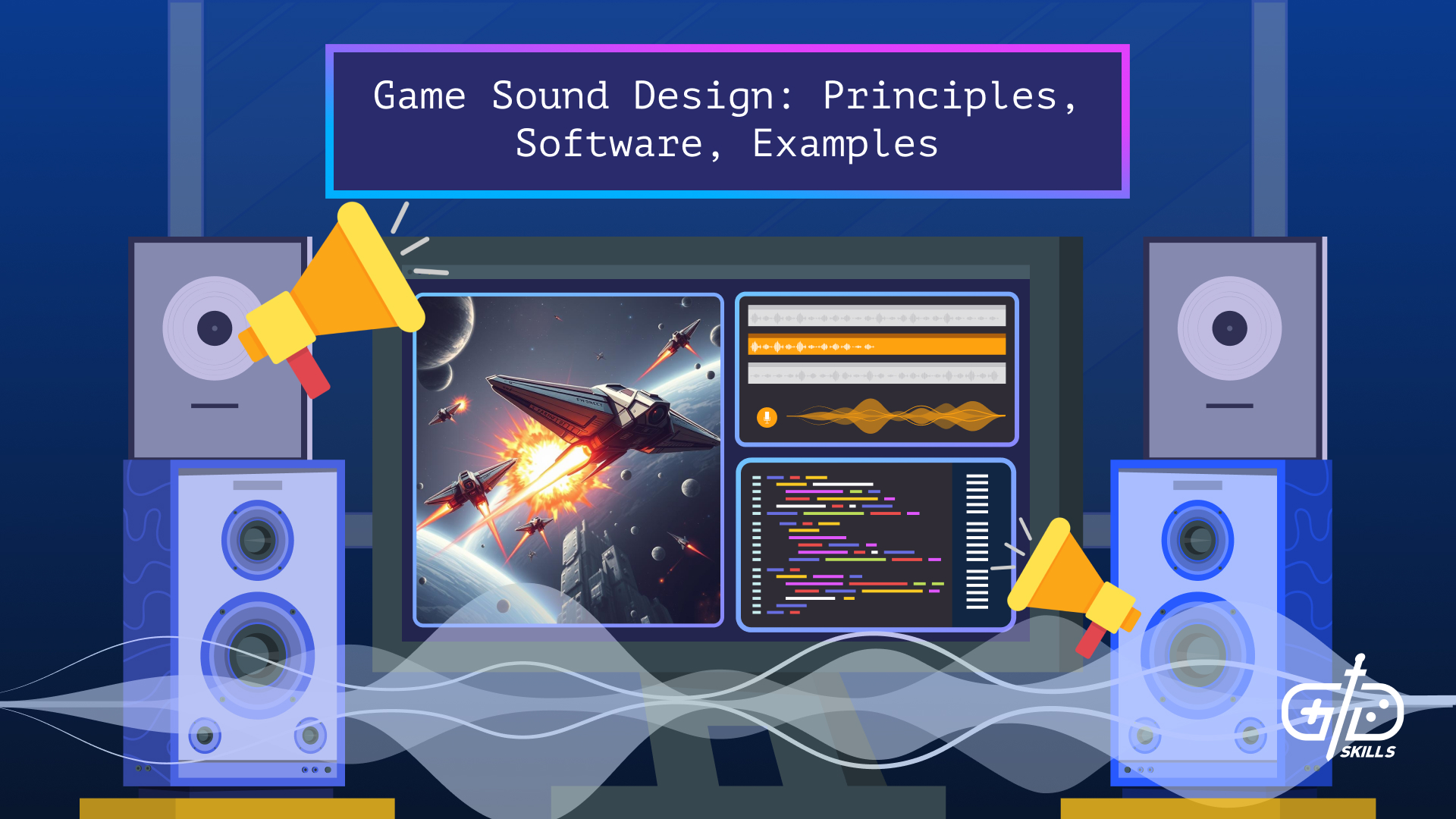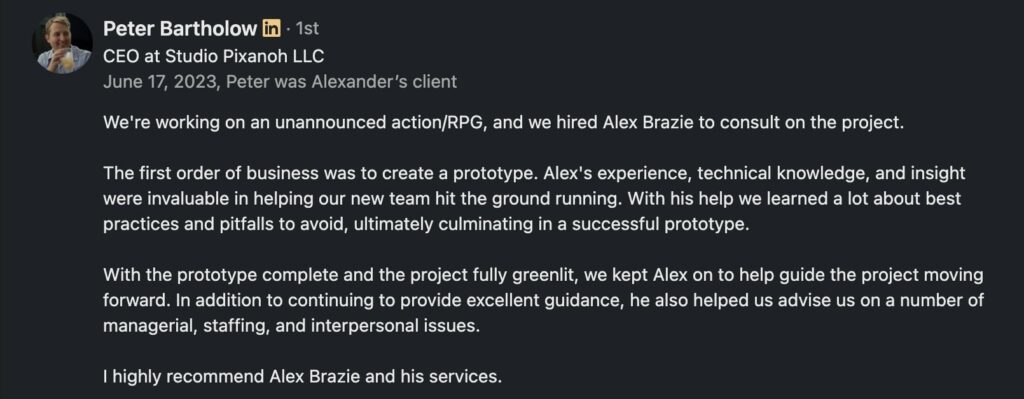Game sound design guides the player through the game world, reinforces systems and mechanics through feedback, creates an immersive environment, and rewards the player for their efforts. Effective audio design requires understanding that the human ear has a limited bandwidth for sound that must be leveraged to focus on what’s important.
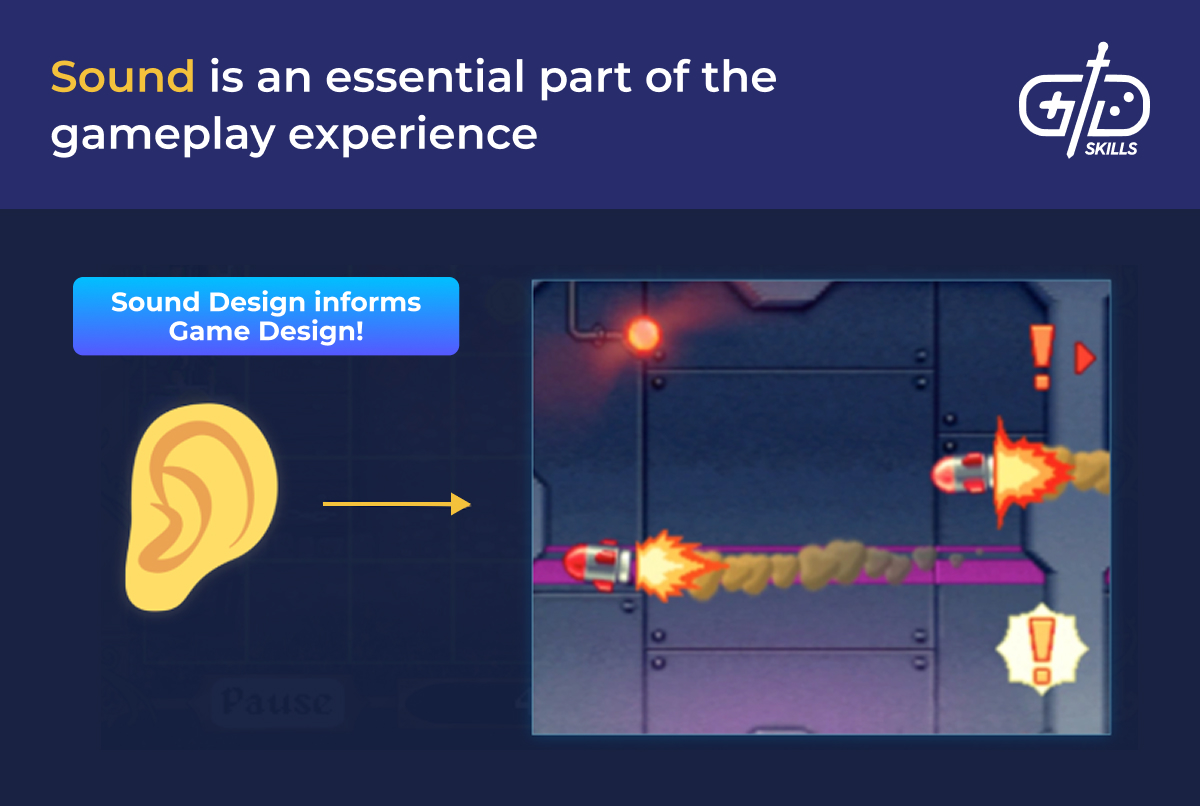
Sound design for games covers sound effects (SFX), ambience, UI/UX sounds, character/creature sounds, and the systems for creating adaptive audio. Sound designers use tools and programs like a digital audio workstation (DAW), middleware software to interface with game engines, and sound libraries to catalogue and create sound effects. Read on to learn more about video game sound design, its principles, software, and some examples.
What is video game sound design?
Video game sound design is the process of creation, selection, and integration of all audio elements into a game. Sound design informs game design. Games create their identity and gameplay through sound as well as visuals. Effective video game audio enhances immersion and increases realism and wonder by grounding actions in familiar or fantastical audio. Sound design for games covers everything from the menu selection to ambience to the report (muzzle sound) of gunshots to the roar of monsters. Effective sounds reinforce a sense of place and make every action feel significant.
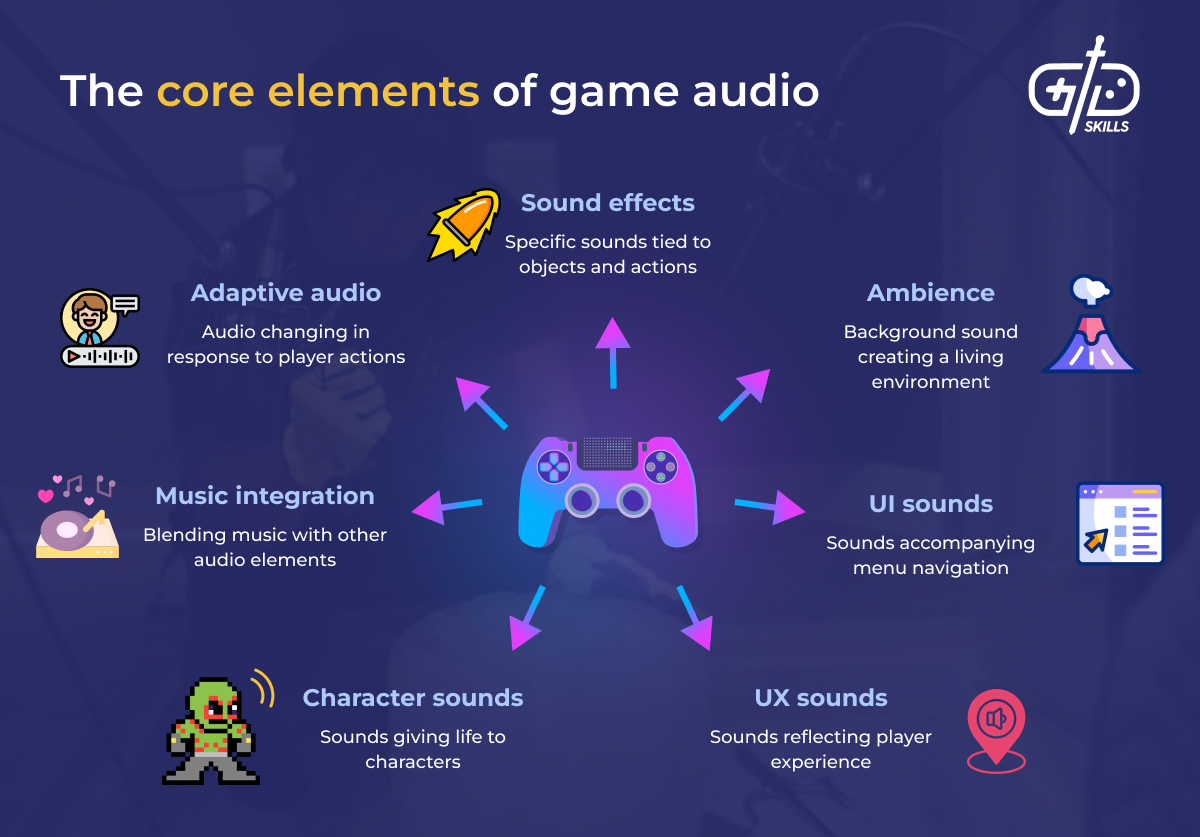
Video game sound design breaks down into the categories below.
- Sound effects (SFX): SFX are highly specific, often short sounds that are tied to particular objects and actions. Examples include gunshots, doors creaking, tires screeching, punches, and engine sounds. SFX help to communicate player action, environmental details, and guidance on navigating the game space.
- Ambience: Ambient sound refers to the background sounds of the game environment. Depending on the setting, ambient sounds include bird song, traffic sounds, machinery noise, people chatting, or any other sound that effectively transmits the feeling of being in a living, breathing space.
- UI sounds: Navigating menus, selecting options, and pulling up menus and option screens are accompanied by sound. UI sounds are typically non-diegetic (meaning they don’t represent objects in the game world) while reinforcing player action and helping players orient themselves through audio. Effective UI sounds give tactile feedback to player input and improve clarity. Sounds accompanying UI elements are repeated many times over the course of a game, so they mustn’t be fatiguing to the ear.
- UX sounds: UX sounds are designed to help players understand how to feel about their gameplay experience. Based on how they’re acting and interacting with the game world, these kinds of sound effects indicate whether players are performing, thereby reflecting the player experience itself. In Super Mario Bros., for instance, gaining a 1-up or losing a life has a distinct sound with a positive/negative connotation that worldlessly conveys clear results to the player.
- Character and creature sounds: Every sound a character or creature makes, like grunts, breathing, dialogue, laughter, and screams, must be captured and mixed. Effective character and creature audio breathes life and personality into creatures and NPCs while giving the player feedback on their character’s state.
- Music (integration + mix only): Music in games is either presented as coming from a local source in the game world or beamed into the mix as a score. In both cases, the sound designer must find space for the music to sit with the rest of the audio elements.
- Adaptive audio: Adaptive audio changes in sync with the player’s actions. In Pikmin 3, a game about managing a small workforce of characters called Pikmin, the sound design adapts depending on the assignments your Pikmin are working on. If your Pikmin are constructing bridges or deconstructing dirt walls, for example, the lower frequencies of the background music are enhanced and new layers of instrumentation such as percussive drums are added to the soundscape.
What is a game sound design document?
A game sound design document (GSDD) is a blueprint outlining all the requirements, goals, and implementation strategies for a video game’s sound design. A GSDD is the audio equivalent of a game design document (GDD), serving as a reference point for the entire team as they develop a game’s audio. The GSDD contains information on what sounds are needed, what function they serve in-game, and how each sound is integrated into the mix.
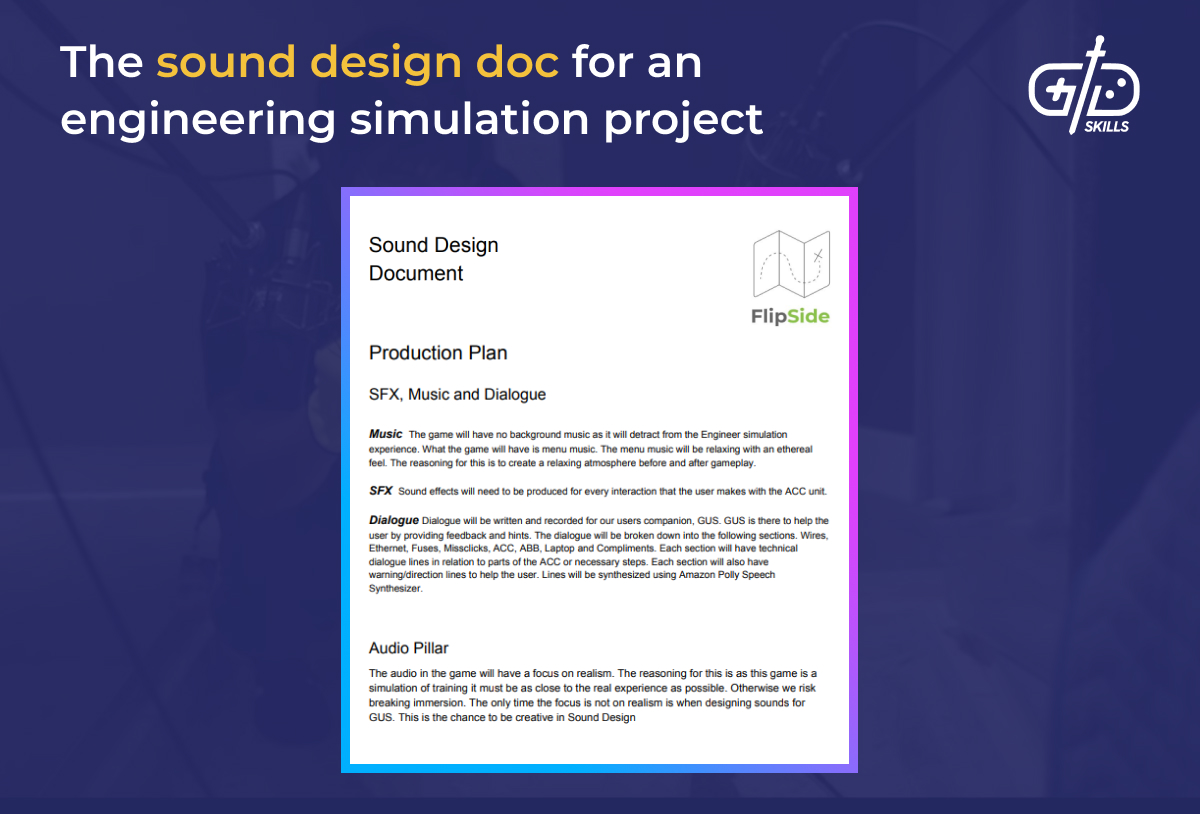
The contents of a typical GSDD are outlined below.
- Vision: The vision section of a GSDD gives a high-level overview of the game’s audio identity. An example is: Sound design is focused on gritty realism with weapons and environmental ambience feeling grounded in reality.
- Assets and classification: This section of a GSDD gives a breakdown of all the sounds required for the project, often classified into groups for easier reference. Example groups include player actions (footsteps, breathing, grunts), environmental and ambient sounds (weather, wind, traffic), character and creature sounds (voices, barks, chatter), and UI sounds (menus, notifications, clicks).
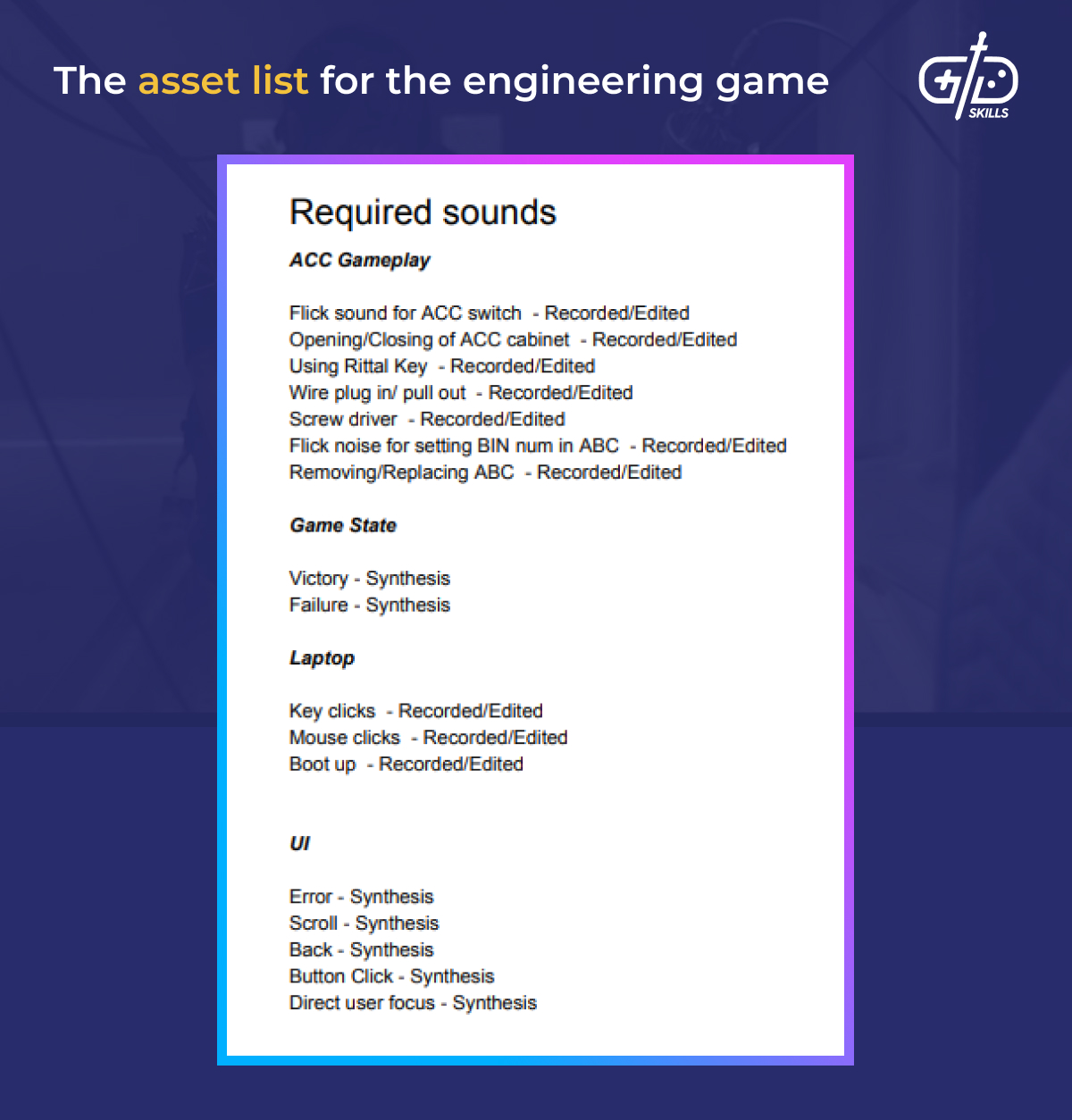
- Sonic Stylization/Branding: This section outlines the music and sound assets central to developing the identity/theme of the game project. It features examples of instrumentation, sound effects, and audio processing tools like equalization (EQ), compression, and impulse response strategies.
- Technical info: The technical info section of a GSDD details the file naming conventions, supported file formats (such as WAV, OGG, and MP3), sample rates, bit depth, and any details about memory and performance constraints that affect the audio.
- Interactive systems overview: This section describes the ways that sounds adapt to gameplay. The difference in walking on stone versus earth are an example of an interaction where collision data informs the system to change the footstep sound. Dynamic changes in audio when the player sneaks, draws a weapon, or aggros a creature are more examples of interactive, dynamic audio.
- Implementation notes: The implementation section details how each sound behaves in the game. It includes information on when and why a sound triggers, randomization, 3D audio placement, and rules for dynamic mixing. Trigger conditions for sounds run from reloading to opening doors to UI selection sounds. Randomizing audio reduces fatigue. Hearing an identical footstep sound at the exact same velocity over and over is suboptimal and unlike reality. Dynamic mixing rules duck some sounds in the mix to highlight others. An example is limiting footstep sounds while characters are speaking.
- Pipeline and workflow: The pipeline and workflow section of a GSDD details a milestone delivery schedule and explains who’s responsible. This section also explains the workflow process, detailing the steps, QA requirements, and review and feedback protocols. The pipeline and workflow section lists what assets are required at each stage of development: prototype, alpha, beta, and release.
Which game has the best sound design?
The game that has the best sound design is subjective and depends on the expectations and preferences of the player. There are games that are universally praised for various aspects of their sound design. Rail shooter Rez from 2001 had percussive player input sounds that put players in a Wassily Kandinsky-inspired liminal game space that was part sweaty rave and part arthouse installation.
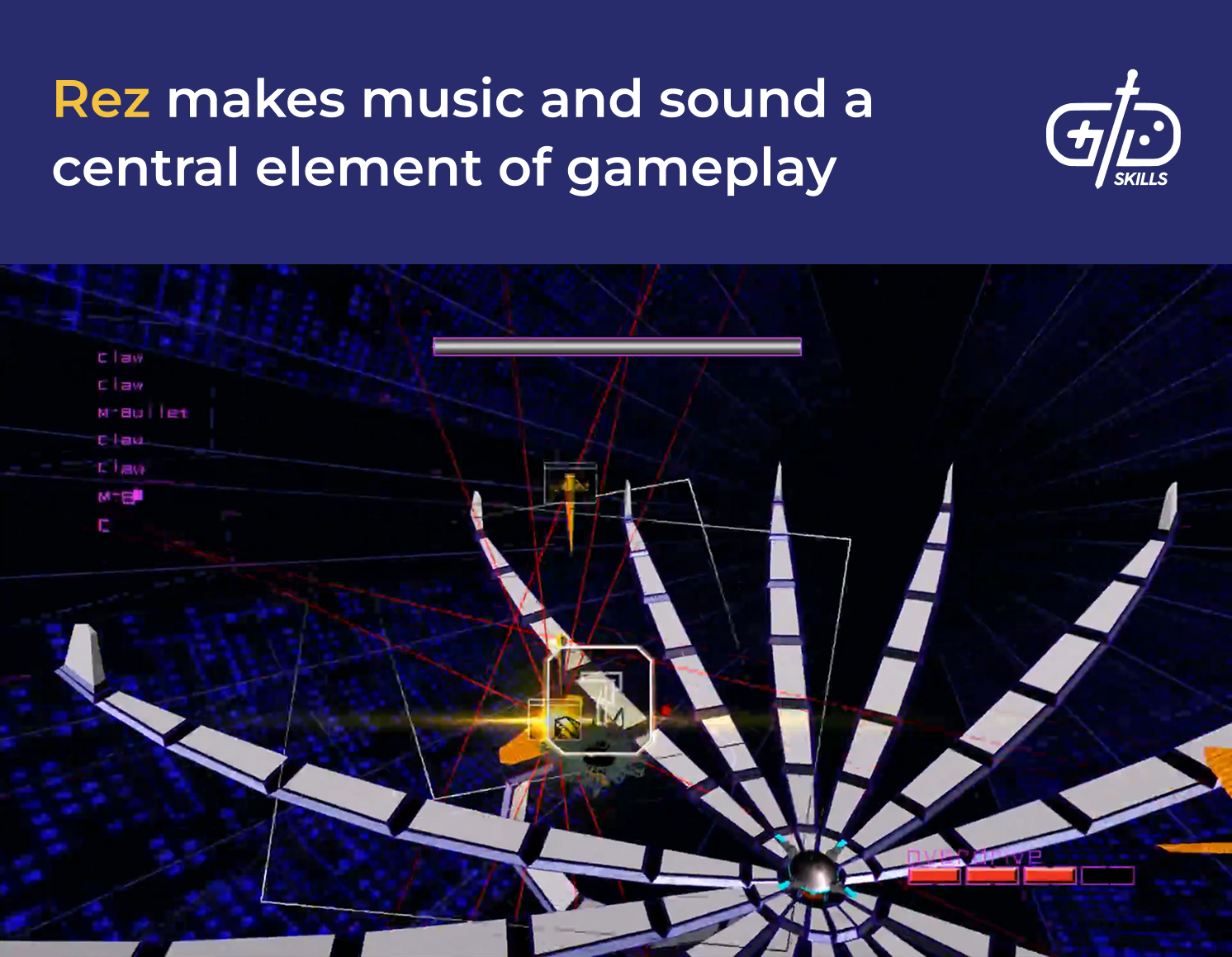
Thief 2: The Metal Age from 2000 made important contributions to sound-as-gameplay, basing success on hearing enemies while not being heard and changing footstep sounds according to surface type. Devil May Cry 5 features a dynamic music system that encourages players to reach peak performance by layering audio tracks as the player increases their points.
Checking the official “best of” lists for sound design gives us some indication of what audiences and critics respond to. The list for best game sound design from the year 2000 includes titles like Deus Ex for its urban cyberpunk ambience and reactive sound and Baldur’s Gate 2, praised for its quality voice acting and spell effect sounds. Notable BAFTA winners for sound over the last quarter century include Dead Space in 2008 for its considered use of silence, aleatory score, and terrifying sound of its necromorph enemies.
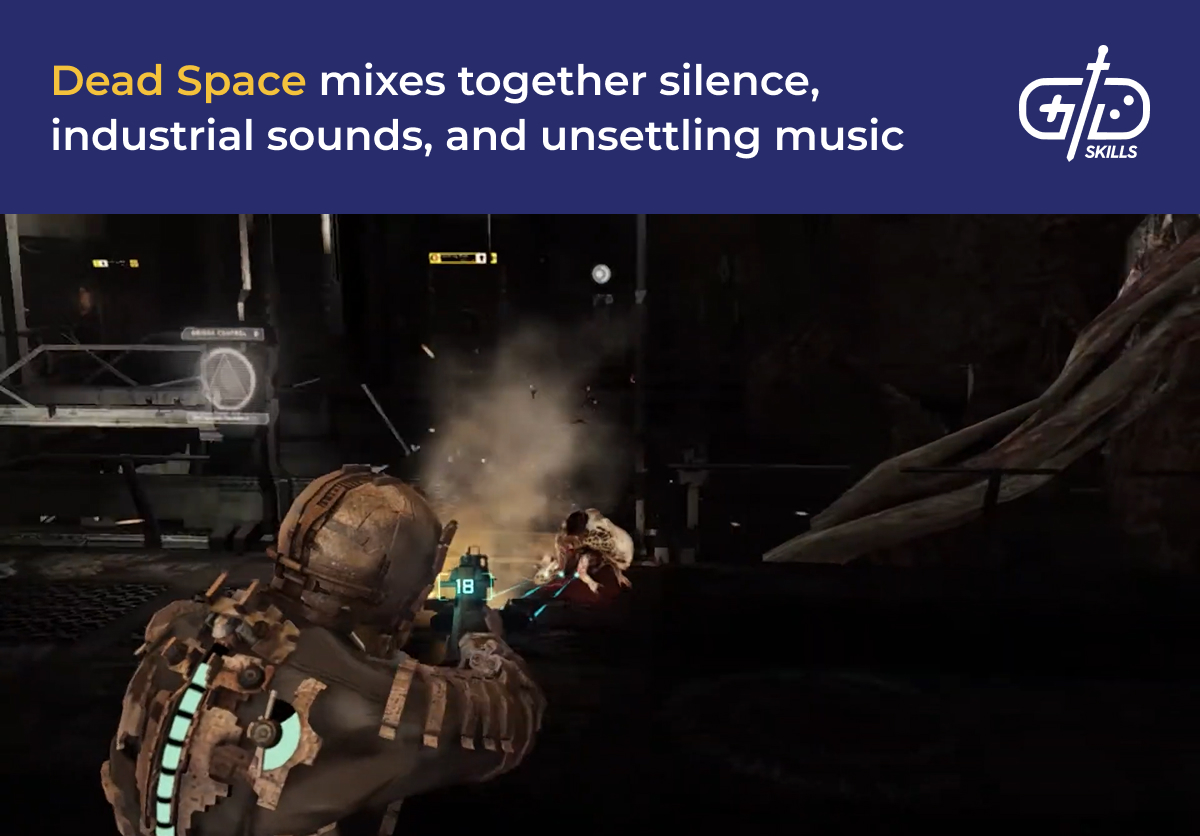
Alan Wake 2 won a BAFTA for Audio Achievement in 2024. Alan Wake 2 was praised for its dynamic audio-driven system that made sound effects adapt to the narrative’s pace and tone. The Game Award for the Best Audio Design in 2024 went to Senua’s Saga: Hellblade 2, praised for its binaural sound that mimics the effect of psychosis in the player character. Player consensus (and a scroll through Reddit) suggests many consider Alien: Isolation, Amnesia: The Dark Descent, and the Silent Hill series to feature some of the best horror game sound design.
What are the principles of game audio and sound design?
The principles of game audio and sound design are establishing player focus, player motivation, a core audio identity, and player rewards. Sound design must focus on what’s important to the player, helping them to navigate the game space, pull off combos and dodge enemy attacks. Audio must also show the player why they ought to care. Specific sounds often precede or accompany significant events or progressions, showing the player why it’s worth engaging. Sound design acts to establish a game’s core identity by focusing on a specific style. Audio also acts as a reward for player accomplishments, triggering satisfying sounds at key points.
Sound’s purpose in games is to direct the player’s attention to the most important parts of the game world. The human ear gets overwhelmed by too many sounds at too great a range of frequencies. Our ears have developed over millenia to effectively hear each other and imminent danger from predators and environmental threats. Effective sound design leverages frequencies and sounds to catch and guide player attention with this knowledge in mind.
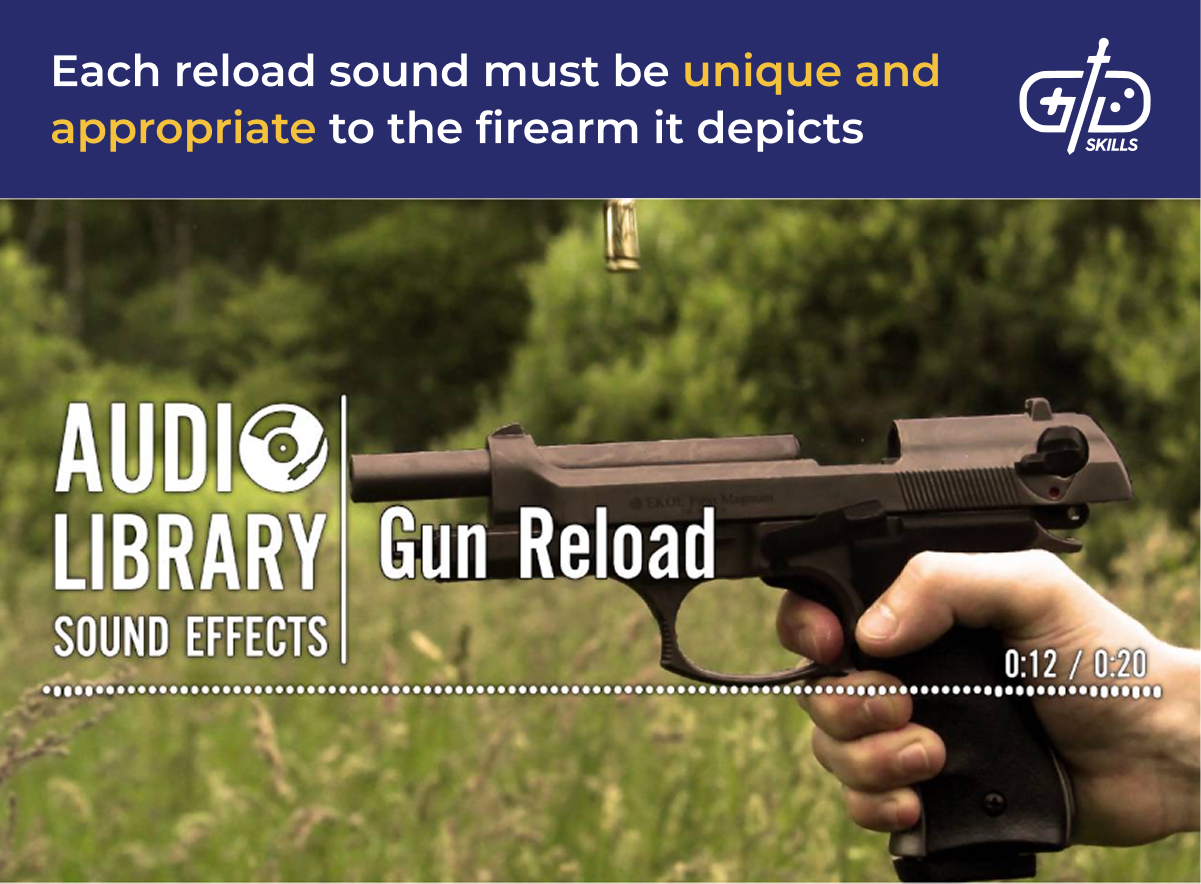
The audio in P.T (essentially a Silent Hills demo) is an excellent example, where environmental sound cues guide the player through a cramped house. Rainfall at the window guides the player to look outside, and eerie shrieks from above force the player to turn their attention toward the ceiling, with whispers and breathing that disorientingly seem to come from multiple places at once. Footstep sounds in P.T are tied to player movement, but deliberately feature random, extra footsteps that clearly aren’t the player’s. This misdirection blurs the line between real threats and psychological distortion from terror in the player character.
Game sound must show the player why they care and why they want to continue engaging with a game. Sound guides players toward systems and mechanics by using specific sounds for successful or unsuccessful actions. Stingers (also called bumpers) are short but powerful musical or audio cues that accompany action on screen. Mario’s jump sound from the 1985 Super Mario Bros. is an example of a stinger. Sekiro’s stinger sounds for sword combat are a modern example. Specific clash sounds indicate effectively deflected enemy attacks, and a drum sound guides the player on the best time to launch a counter.

Devil May Cry (DMC) is an example of how music reacting to gameplay reinforces effective play styles. DMC ranks players according to how stylishly they play. As the player’s style meter increases, so do the number of musical layers in the song. Guitars, synth, and vocal layers add to the mix in real-time as the player progresses through the letter grades assigned to their style from C to S. Once the enemies are defeated, a piece of scripted outro music plays to finish the encounter with a fitting climax.
Audio design plays a major role in defining the tone, atmosphere, and immersive quality of a video game. Doom Eternal’s hyper-violent power fantasy shines through every element of its design, including the audio. Doom Eternal doesn’t try to build tension and dread, like P.T. Instead, the sound design focuses on momentum, flow, and clarity. The industrial metal tells the player not to expect a ponderous, slow-paced experience, with the score adding layers and increasing intensity along with the action.
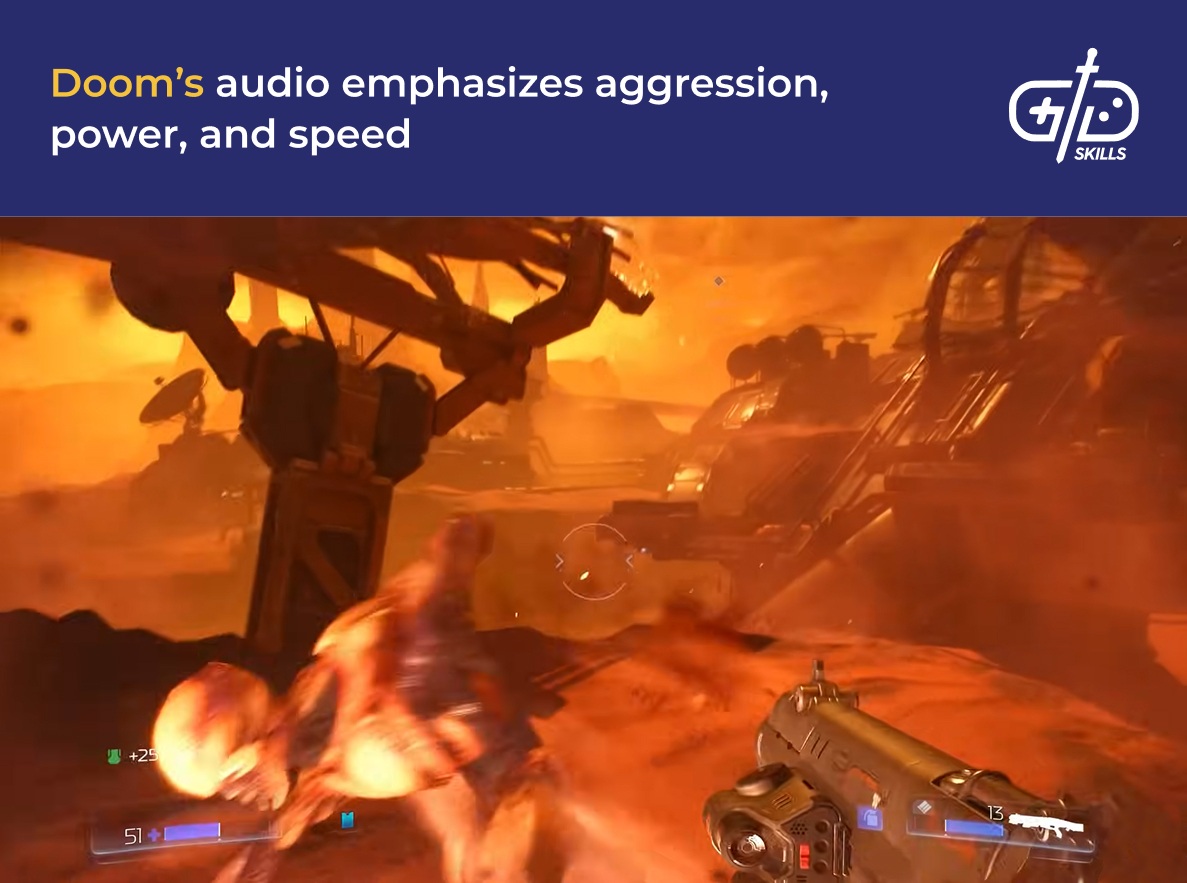
Doom Eternal’s music and gameplay emphasize the violence in concert, but the mix never gets murky despite the layers. Enemy attacks in Doom Eternal use frequency separation to remain distinct and readable, even in high-action moments. The Marauder shotgun is a crisp, short sound, while the Cacodemon’s weapon charges up with a low, sustained hum. These features keep Doom Eternal’s gameplay clear and flowing.
Game audio must reward players for their accomplishments, too. Linking sounds to positive outcomes provides gratification on a micro and macro scale. Games like Candy Crush use vibrant stingers and musical cues for effective plays, encouraging players to string them together for better combos and more sound. Candy’s Crush’s constant audio affirmation keeps players engaged at all times.
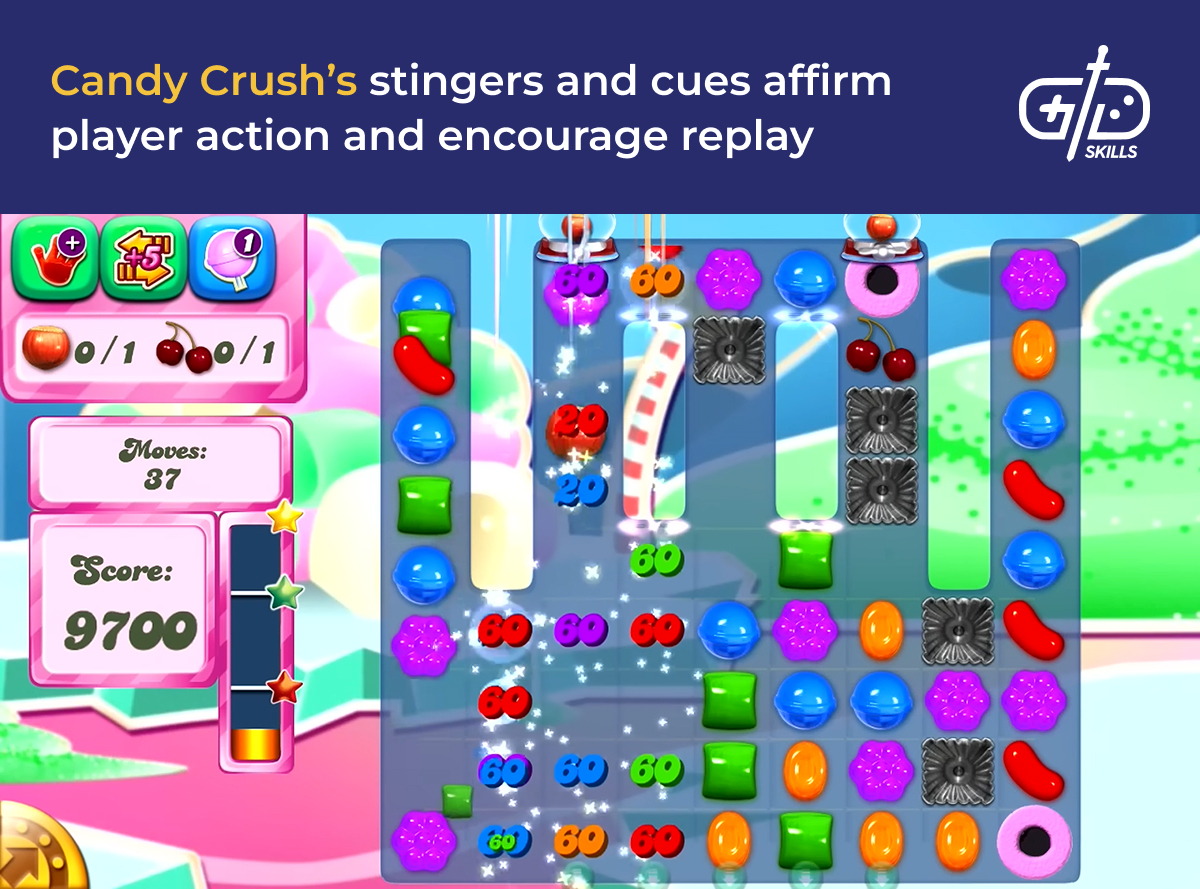
Super Mario Bros. 3 uses a celebration stinger musical cue when the player completes a level. It’s infrequent enough to feel satisfying when it plays and the sound conditions the player to push forward to the end of the next level. Level up sounds in a title like Skyrim provide similar but slower-burning feedback on satisfying progress. The Skyrim player hears an audio cue and knows without looking at their character screen that they’re about to gain some new power.
What are examples of game sound design in games?
Doom’s hyper-aggressive, flow-focused audio, Legend of Zelda: Breath of the Wild’s mix of realistic ambience and fantasy magic, and Sekiro: Shadows Die Twice’s crisp, readable combat cues are examples of game sound design. Each game uses its audio to reinforce its gameplay and identity. Doom is chaotic but clear, syncing audio intensity to onscreen action, Zelda’s audio emphasizes semi-cozy exploration in a fantasy world, and Sekiro teaches players to use audio as guidance in challenging combat encounters.
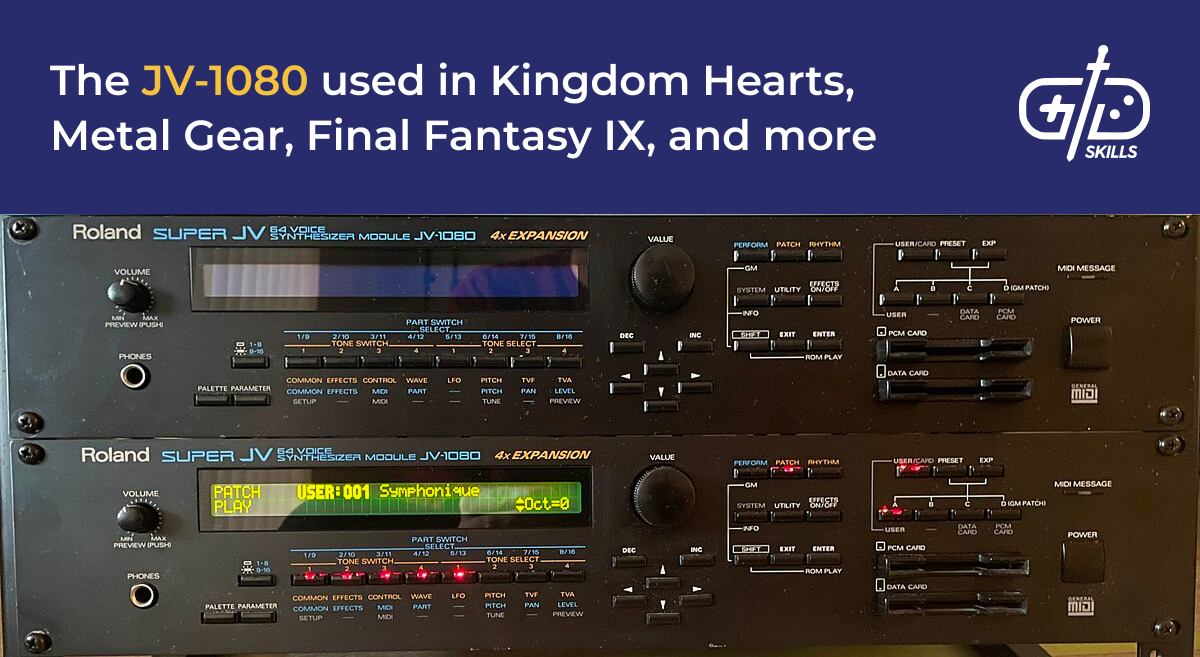
I was personally inspired by the late 90’s/early 2000’s aesthetic of games like the Playstation Mega Man titles that relied on romplers like the JV-1080 or SC-55. These sculpted an EDM/Synthwave/Drum’n’Bass experience that was as exciting as it was ethereal. Every sound designer draws from a different set of cultural references, giving each game’s audio an identity rooted in the sounds its designers have experienced.
What software is best for game sound design?
The best software for game sound design is the software you’re able to afford and have an effective workflow for. That said, there are industry-standard options for digital audio workstations (DAWs), middleware (software that acts as a bridge between audio assets and the game engine), and libraries and creation tools where the sounds for the game are selected or created.
Avid’s Pro Tools is considered the industry standard for post-production work, but I personally recommend Reaper as your first DAW, as it has many of the same features with a similar interface. Reaper also lacks the regular subscription costs and iLok verification featured in Avid products. Ableton Live is a flexible option with a fast, streamlined workflow for creating sound effects with layers. For a Mac user, Logic Pro on Mac is another viable alternative, as it features a massive library of sounds, effects, and plugins.
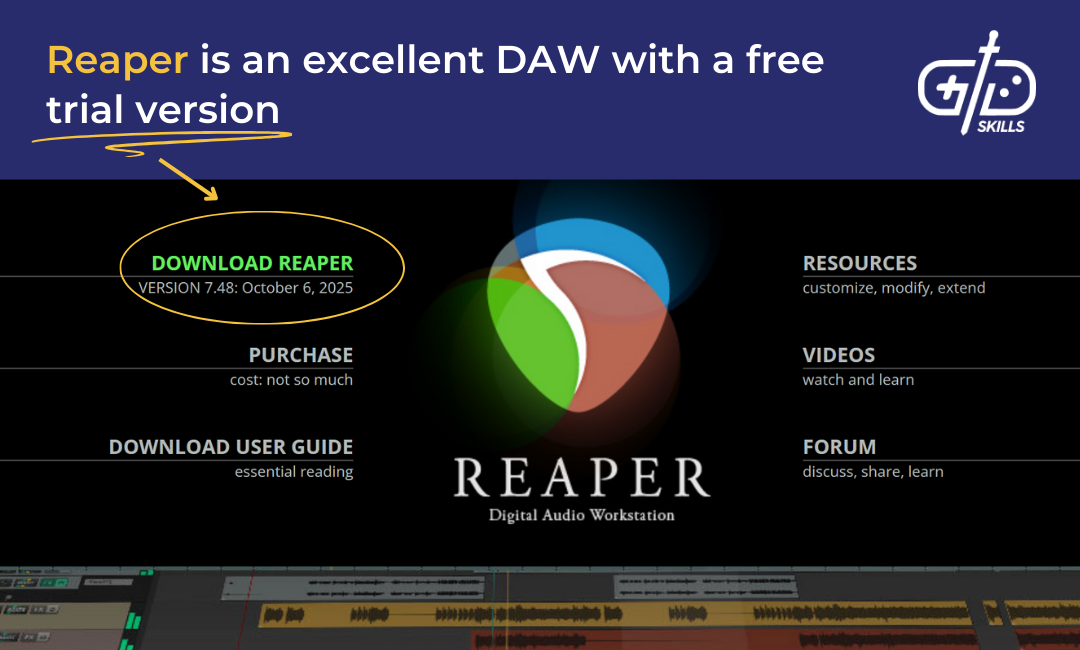
Middleware takes the audio assets created in your DAWs, optimizes them for the game engine, and turns them into adaptive, dynamic parts of gameplay. Middleware allows for dynamic music changes, reactive sounds, and using audio as an interactive part of video game design. Firelight Technologies’ FMOD gives designers a visual interface to select the parameters of audio interaction. FMOD is considered more accessible and features more plug-and-play options than its competition, Wwise. Audiokinetic’s Wwise is the most widely used middleware in the AAA space, allowing designers to control how sounds behave and interact without heavy coding.
Soundly is a sound effect/audio library program that also acts as a library management tool. Soundly gives access to a large bank of sound effects and samples that support drag and drop functionality into DAWs like Reaper and Logic and cloud storage for teams. Serum is a hybrid engine/wavetable synth that allows users to load or design wavetables and morph between them, creating evolving timbres and sounds. Sonniss is another library suite that offers royalty-free sound libraries from the video game, movie, and TV industries.
How to learn game sound design?
Learn game sound design by listening to video game audio critically, analyzing which audio elements contribute to gameplay and immersion and which don’t. Then, find out how the sounds you respond to were made: wavetable synthesis, samples, or a combination of techniques. Getting started making sounds for games and other media is simple and inexpensive. A laptop and a free version of Reaper, FL Studio, Logic, or Ableton are all you need. Many sample packs and synth plugins are available entirely for free or as trial versions.
Online course providers like Udemy and Coursera offer essential courses teaching the basics of sound design for video games. These courses are an OK starting point for a complete beginner, but many comparable instructional courses are available for free on YouTube. Specialist courses from platforms like GameDev.tv, Berklee College of Music, and ThinkSpace Education offer more in-depth, industry-preparation-style coursework online. Anomalia offers tools-focused courses teaching software like Wwise and its application in Unreal Engine.
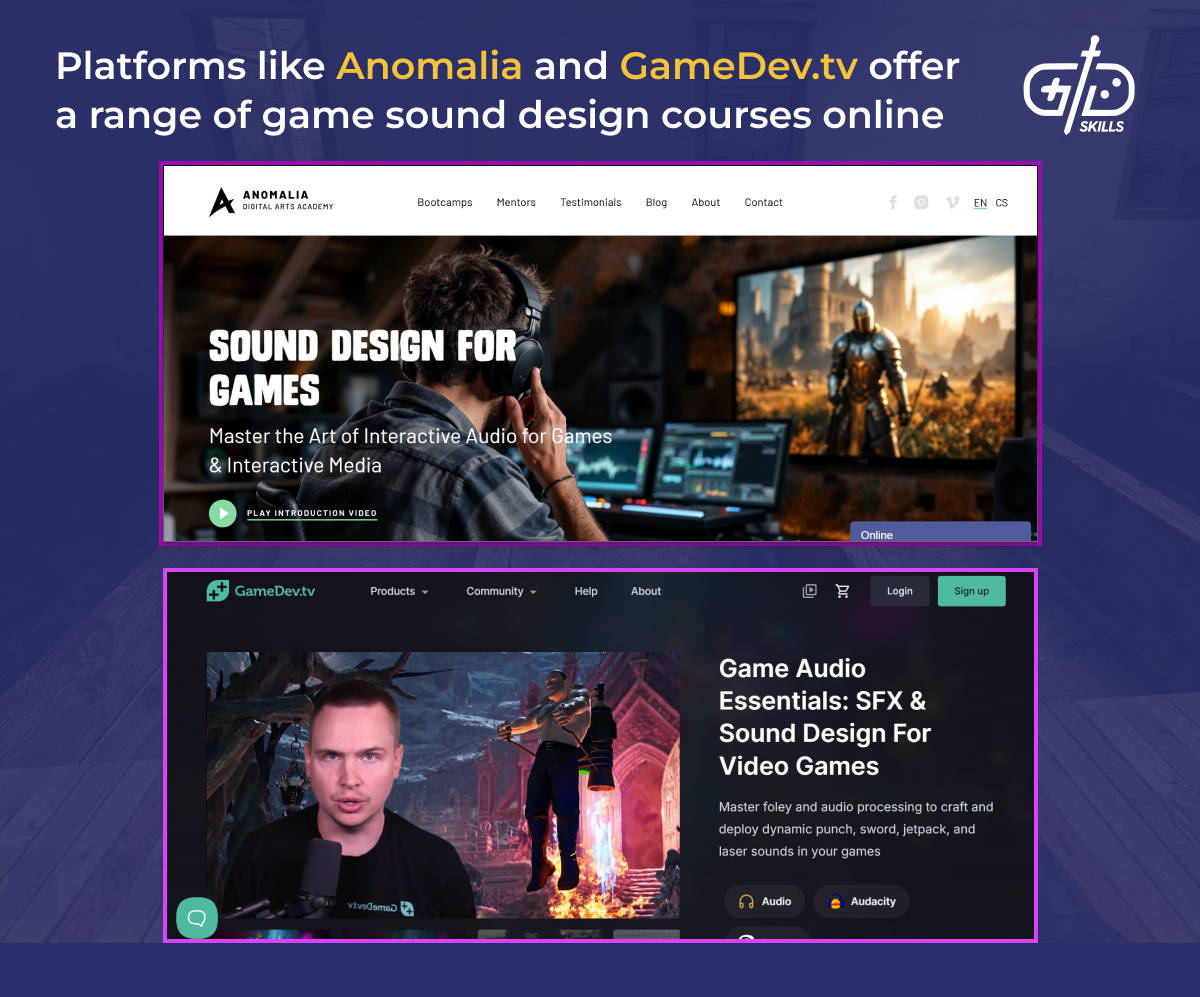
Books from veteran video game sound designers and instructors are valuable tools for anyone learning to create audio for games. Karen Collins’ Game Sound is a historical overview of sound in video games and how it differs from other media. Robert Ciesla’s Sound and Music for Games: The Basics of Digital Audio for Video Games explores both the tools and practices of modern sound design and the creative choices that underpin them.
Communities on places like r/GameAudio, Discord servers, and YouTube channels give beginners a chance to ask questions and learn from more experienced devs. Game Audio Learning on YouTube gives career advice and tutorials on specific tools like Wwise. Ross Tregenza is a professional video game sound designer with a YouTube channel offering demos, explanations, and sound design breakdowns. YouTuber Blackthornprod gives easy-to-follow advice for simple audio design for beginners.


